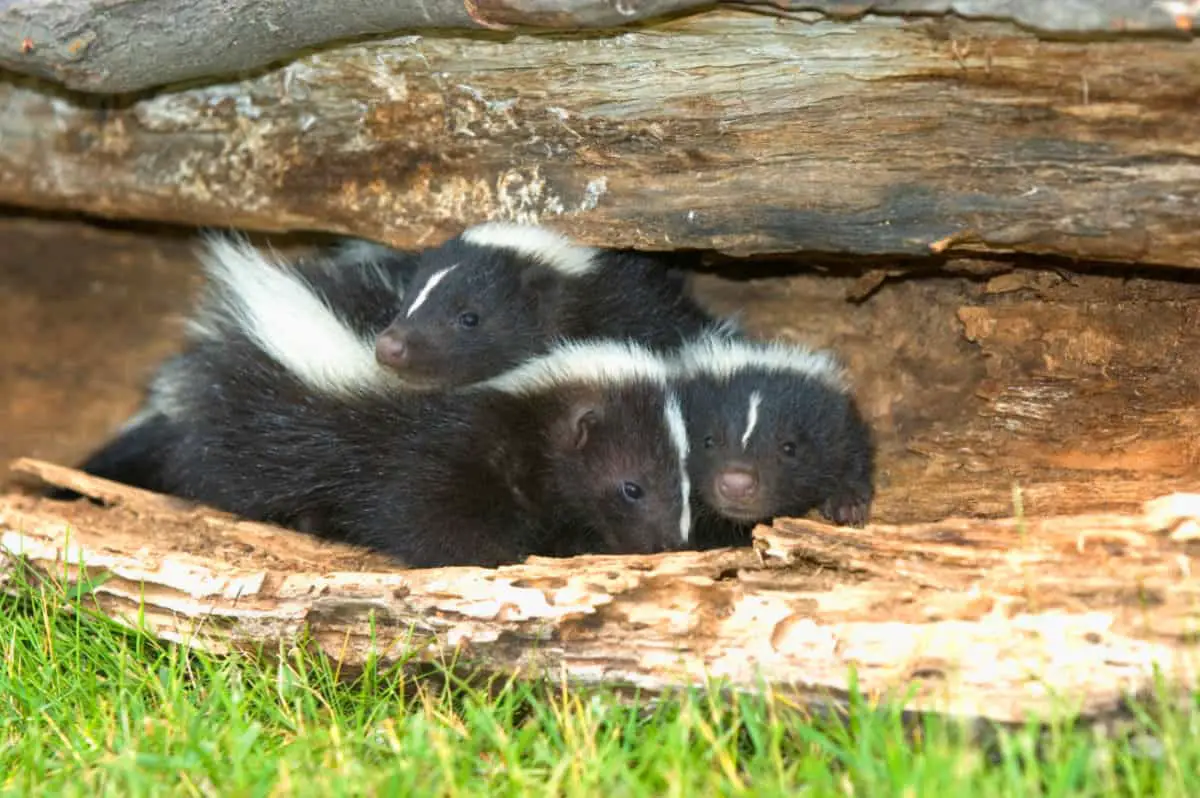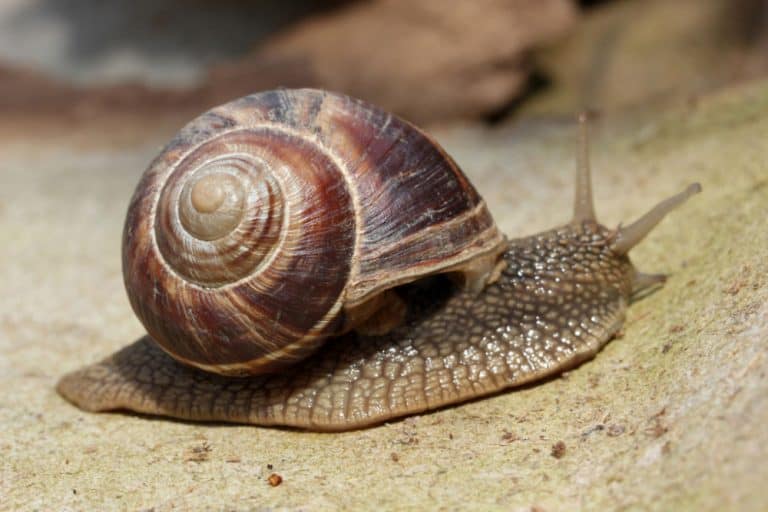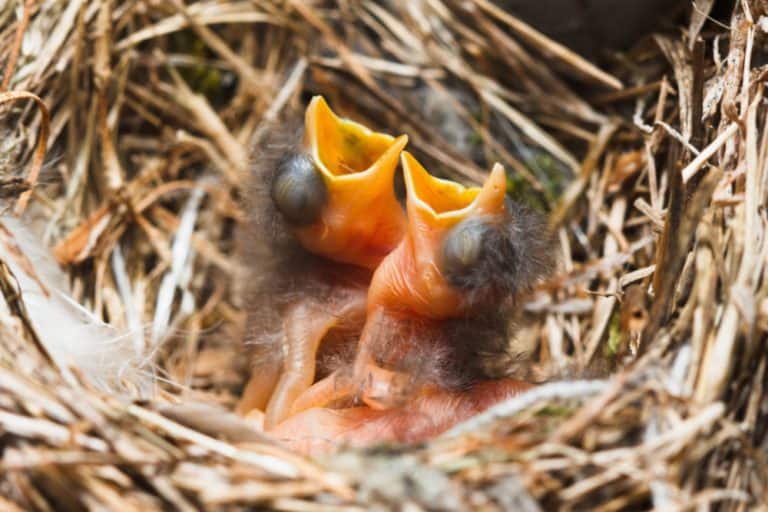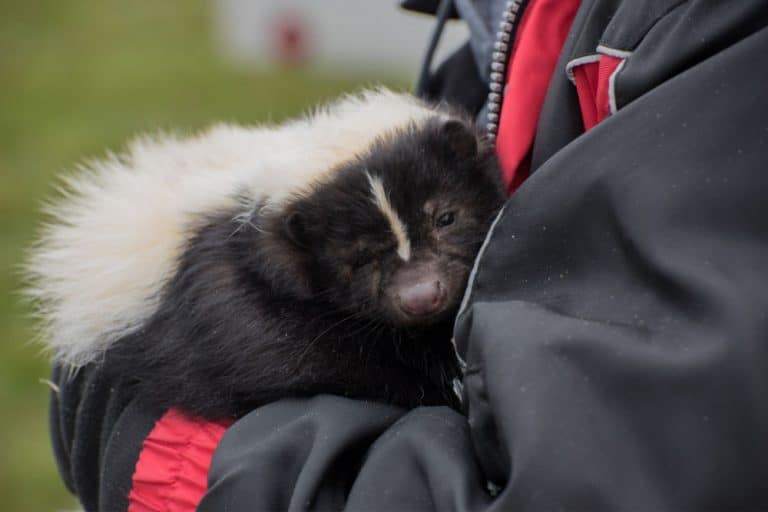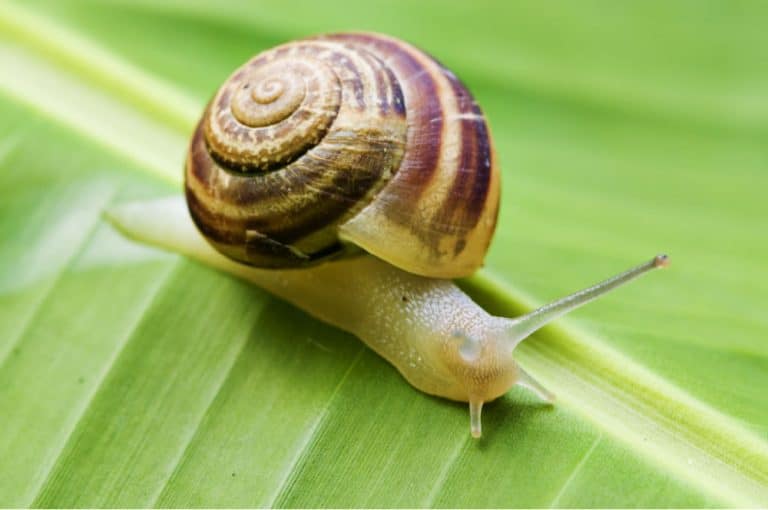What To Feed Orphaned Baby Skunks?
Whether you live in an urban area or out in the country, skunks are everywhere. And it’s about the time of year when baby skunks are found orphaned. Most people immediately want to bring those babies in and care for them. But they can be a lot of work, especially when it comes to feeding. So let’s go over how to care for these kits. And most importantly, what to feed orphaned baby skunks.
Making Sure The Kits Are Orphaned
As humans, we like to swoop in and save helpless baby animals without giving it much thought. But we encourage you to take a step back from the situation. We need to make sure that these babies are actually orphaned and that the mother isn’t coming back for them. So keep an eye out on the baby. And if the mother doesn’t arrive within 5 hours, take the baby inside.
Five hours is the perfect amount of time to wait since most kits are fed every 4-5 hours. So if your kits are still outside, take a dry towel and wrap them up. If the kits are small with little hair, you will need to keep them in a dry, dark place. If there is only one baby, you will also want to look around for others. Most skunks will have anywhere between 4-6 babies at a time. And if you rear more than one together, they have a better chance of survival.
Checking The Laws
Now that the orphaned skunks are inside and safe, you will need to check your local laws. Currently, it’s only legal to keep skunks in 17 states. And if you have too much contact with the kits, it’s nearly impossible to release them back into the wild. So it might be best to contact your local wildlife agency to care for the skunks. But not everyone has a wildlife agency equipped for this, and that’s why we will help you.
Preparing A Home For Them
One of the first things you will need to do is figure out where to put your baby skunk. A warm dark place is best for them with old towels for bedding. Some people prefer to use an old cardboard box, but it won’t be long until they outgrow this. When your kits turn three weeks old, they will need to be transferred into a kennel or pet carrier with less than an inch bar spacing. You could even use rabbit or guinea pig cages if you have access.
The First 24 Hours
Now that your skunk kits are inside and safe, the most important thing to do is warm them up. Most people want to jump right into feeding and giving animals water. But this could cause more harm than good. The reason for this is that it takes a lot of energy to digest food. And if you feed them before their body temperature is stabilized, it could displace where their energy is needed most.
Keeping warmed rice bags or hot water bottles are perfect for warming up your little skunks. Once your kits are warmed up, you can give them liquids to rehydrate. But you don’t want to provide them with regular water. Instead, you will want to syringe feed them unflavored Pedialyte warmed to body temperature to get them rehydrated. Every few hours, give them as much as they can drink without it coming out of their nose. If the liquids start bubbling up, that means they are over drinking. Just turn them upside down and gently pat the baby’s back, and all will be fine.
Estimating The Age & How Much To Feed
With your baby skunk rehydrating, it’s time to start guessing how old your baby kit is. To do this, you will need a scale and an excellent observation of the skunk. Here is what to look for when guessing how old your kits are and how much to feed them. You can also use this as a guide to keeping up with your skunk’s growth and development.
Birth
When a skunk is first born, they are naked with closed eyes and ears. These little guys are only 30 to 35 grams. So it’s very unmistakable when you have a kit that is a newborn. A baby skunk this young will be eating 2-2.5 ml of formula 5-6 times a day. That means you will need to be ready to feed every four hours, day and night.
One Week Old
In that first week of life, the baby skunk grows a lot. They are getting a fuzzy halo of hair all over their bodies, but their eyes and ears are still closed. If you suspect that your skunk is a week old, you should feed it 4-6 ml of formula 5-6 times a day. A baby kit will also weigh about 50-75 grams, but depending on how long this kit has been orphaned, it might have lost some weight. They will gain that weight back quickly, and then some.
Two Weeks Old
Once your kit is two weeks old, it becomes fully furred. They won’t have their ears and eyes open just yet, but it will happen soon. Your skunks will weigh about 125 grams at two weeks old if they have developed on time and not left abandoned for long. They will also increase the amount of formula and decrease the feedings at this time. With only 8-10 ml four times a day, so you can finally get more than a few hours of sleep at night.
Three Weeks Old
At three weeks old, your baby skunk will just start to open its eyes and ears. They might even start trying to get around a little bit with this newfound eyesight. But the movements will be very jerky still and not coordinated. Your baby skunk will also start drinking more milk than they have previously. With 10-15 ml four times a day, your skunk will go through a rapid growth spurt.
Four Weeks Old
Now your skunks will start to get fun around a month old. With eyes open, ears open, and the strength to pull themselves up, your kits will begin to make their way around. They will start to roam and play around the nesting space. They will also start to really pack on some weight. By four weeks old, your kits will weigh 340 grams, and eating enough for it too.
Your kits will still be getting 15-20 ml of formula. But you will also want to introduce high-quality dog food at this time every morning and every night. In a shallow dish, wet the food down until it expands and becomes soft. And don’t forget to give them fresh water along with this new food.
Five Weeks Old
By five weeks old, your kits will be playing with confidence and romping around. And yet again, you will need to up the amount of formula you feed your kits. 20-25 ml per kit three times a day, plus the moistened dog food should be sufficient. But you will also be introducing new foods around this time. Feeding various fruits, vegetables, and bugs will round out the skunk’s diet and prepare them for wild living.
Six Weeks Old
Right about now, your baby skunks will be eating more solid foods than ever before. They are growing and starting to look more like adult skunks. But they are still getting formula a few times a day. 25-30 ml of milk twice a day and solid foods provided in between is enough. You can also stop wetting the dog food at six weeks since all of the skunk’s teeth are strong enough.
Seven Weeks Old
And now it’s time to start weaning your little kits. To start, you will want 30-35 ml of milk once a day and slowly taper off how much you give them. Encourage them to eat more dog food and supplement with lots of vegetation and bugs. Things like mealworms and crickets are full of protein and will fill up your skunk’s stomach well.
How To Feed A Baby Skunk
Now that you know how old your skunk is and what they need to eat, you might be wondering how to feed it. Most people want to jump right in and buy bottles used to nurse kittens or puppies. But you don’t want to do this. Skunks are very aggressive eaters, and if you feed them with a bottle, they will engorge themselves.
Instead, you will need to buy a plunge-style syringe that measures in milliliters for the best feeding. With these syringes, you can control how fast or how slow your skunk will eat. It might also help to get plenty of backups of these syringes. Skunks are notorious for chewing on them and rendering them useless with how aggressively they suckle. So having extras will save a lot of trouble.
Once you have your syringe filled with the proper amount of formula, it’s time to feed. With as little contact as possible, hold the syringe close to the skunk’s mouth. They will move their heads around to find the milk themselves, which also builds up muscle. Feed them slowly and watch for signs of choking.
If you notice milk bubbling out from the kit’s nose, gently pick them up and turn them upside down. Gently but firmly rub their backs until the bubbling and sneezing stops. And don’t forget to clean their little mouths afterward. The formula is thick, and it only gets thicker when it dries. So keep their noses and mouths clean with a damp cloth after every feeding.
The Best Formula
What to feed orphaned baby skunks wouldn’t be complete without talking about the best formula to buy. It’s essential to find a formula that will have everything skunks need. The best formula on the market is Esbilac for puppies.
This milk comes in either a powdered or canned form and most closely resembles a skunk diet. The powdered formula usually costs less and can be made 24 hours in advance and in smaller quantities.
Canned milk might seem like a more convenient way to go but end up being a big waste in the end. The reason for this is that each can spoils 24 hours after being opened. And there’s no way for a skunk to drink the entire can in that amount of time. So to save a little money, you can buy the bigger containers of Esbliac.
The Best Kibble Food
Around four weeks old, you will start to introduce dry dog food into your orphaned skunk’s diet. But you do want to be picky about what type of dog food you get. You don’t want anything too high in protein and have a good balance of natural fruits and vegetables in the mix.
A grain-free small adult dog formulas are best for your baby skunk’s needs. The reason for this is that small breed formulas have smaller kibble sizes for your growing kit. And remember to stay away from puppy foods as they are too high in protein and can cause kidney problems in skunks.
Other Foods
In addition to milk and dog food, you will also need to give your skunks an introduction to what they will eat in the wild. Things like berries, crickets, mealworms, cooked eggs and meat, fruits, and vegetables are all critical to your skunk’s diet. If you don’t feed these types of foods, it can be impossible to wean your kits. Not to mention it will make living out in the wild harder for them.
So how do you feed these types of foods? Most people put them into a shallow bowl until they are strong and move about without a problem. Then you might try hiding it inside the cage under bedding or using products like the Snuffle Mat to enrich them and encourage foraging.
Supplements
Another thing you will need to feed your weaned skunks is supplements. Taurine and bone meal are vital minerals for a growing skunk. These are supplements that wild skunks can find through different food sources. But on a diet of dog kibble and fresh food, your skunks could be lacking.
You can get these supplements at any health foods store, and they come in either powder or capsule forms. All you need to do is sprinkle 150 mg of taurine and 50 mg of bone meal onto their food daily. Your skunks will eat it up and grow up healthy and strong.
Don’t Forget About Stimulating For Excrement
Now, this might sound like a gross subject. But it’s something that most small animals can’t do on their own until they are older. That’s right. You are going to have to help your baby skunks poop and pee. To do this, you will need a cotton swab, warm water, paper towels, and gloves.
Once your gloves are on, hold the skunk over a bit of paper towel or trash can. Dip the cotton swab into the warm water and rub it across the genitals. You can find the genitals at the base of the tail on the underbelly. When you gently massage this area, you mimic a mother skunk’s actions to help her kits go potty.
After every feeding, you will want to do this to make sure that your kits are staying hydrated and nourished. And you will need to stimulate your kits until they are five weeks old. After that time, they will go to the bathroom on their own.
Getting Ready For Release
Now you know everything there is to know about what to feed orphaned baby skunks. Once you get your kits weaned, you will need to prepare them for living out in the wild. Up until now, you have kept your kits in the dark room of the house or garage. But around three months old, they will start spraying and lifting their tails. So it’s best to get them out of the house before then.
We recommend getting an outdoor enclosure 4×8 feet with one-inch wire to put your kits in when they turn eight weeks old. This gives your kits the perfect amount of time to adjust to outdoor life before releasing them. Adding things like a sandpit and nesting box will also encourage them to behave in natural behaviors. Just remember to keep as little contact as possible with them. When your baby skunks turn 16 weeks, you are ready for that bitter-sweet moment of release. You have been a good skunk surrogate, and maybe even some good karma along with it.
And That’s All You Need To Know
With your skunks eating and gaining weight every week, you will feel like a proud skunk mother. Now it’s time to release your skunks into a secluded area away from humans and roadways. Preferably a space with lots of brush cover and a water source nearby. You might even give them a small amount of dog food to get them started until they make their way off. It’s a bitter-sweet, moment, but you’ve done a good thing.

